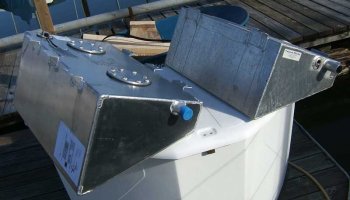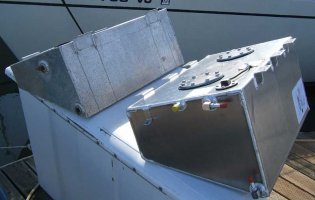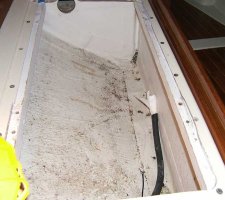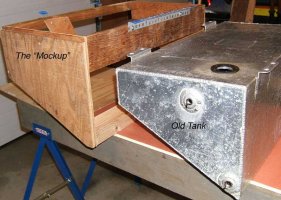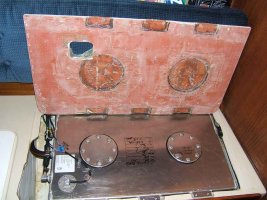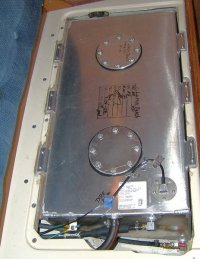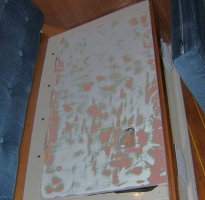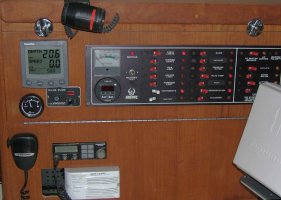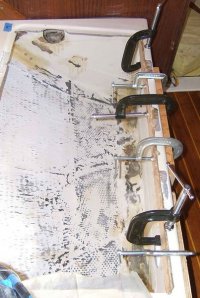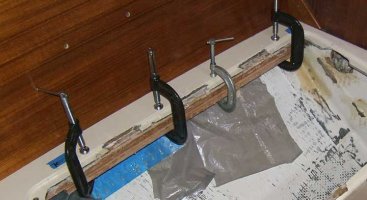http://www.ericsonyachts.org/infoexchange/showthread.php?t=3404
http://www.ericsonyachts.org/infoexchange/showthread.php?t=3585
http://www.ericsonyachts.org/infoexchange/showthread.php?t=6266&referrerid=28
What with several recent threads about fuel pumps, filters, and the mention of fuel tank repairs and/or replacement, I have a report on the diesel tank replacement in our boat.
The factory tank was quite small at 14 gal., 20 years old, needed to have the deck fitting and fill-hose replaced, and needed an upgrade to the vent hose scheme.
Old tank was removed mid-winter, along with fill hose and deck fitting. The tank had no leaks but the old analog gauge on top was seeping some diesel. The fill hose has been permeated for the last several years, and that diesel odor was affecting stuff in the forward hanging locker thru which it passes.
The hull under the port settee where this tank lives needed cleaning, de-molding, and then, like other projects before, sealing it from bilge water entering along the settee front. That settee front needed ventilators anyway. "Every project leads to 3 others."
The settee top opening was widened out over an inch both ways, and new mahogany pieces were attached with epoxy and screws to support the top brackets on a heavier tank having more capacity.
The vent hose was re-routed to eliminate the old problem with sags in the hose run on its way along the underside of the aft deck joint to a vent fitting on the upper transom.
A new vent fitting is now at the inside top of the combing in the cockpit. (Another interesting project by itself.)
New ground wire now, also, from deck fitting to tank to engine ground.
The old deck-fill had lost its chain before we bought this boat and the O-ring was about shot. I installed a new SS Scandvik fitting with a built-in opener pivot tab.
Of course, with that old hose out of the forward hanging locker this was the ideal time to remove the old vinyl hull ceiling material and the hundreds of staples that held it. Filled the divots, cleaned the teak, and varnished out the locker inside. New hull ceiling epoxied in -- formica surface to match the factory counters, over a layer of 7 oz cloth, over a half inch of honeycomb. This makes for a smooth finished look and the composite material even adds some insulation, with very little weight. That locker is now about a useful inch deeper, too, FWIW.
The new tank was mocked up in wood to make the most use of the space without touching the hull. Coastline Tanks (https://coastlinemarinetanks.com )in Bellingham, WA, built it from my drawings. Total cost with delivery was $526. New tank is 1/8th inch, with a baffle, and two cleanouts... and included a sender for an electronic gauge now purchased and mounted in our instrument panel. The factory tank never leaked, but was only 090 thickness, the bare minimum.
We now have a 19 gallon tank! Not a huge change I admit, but it will help a lot on coastal trips.
Attached are some pics of the before, during, and after.
Loren
Note: Coastline web link updated 12-28-21.
http://www.ericsonyachts.org/infoexchange/showthread.php?t=3585
http://www.ericsonyachts.org/infoexchange/showthread.php?t=6266&referrerid=28
What with several recent threads about fuel pumps, filters, and the mention of fuel tank repairs and/or replacement, I have a report on the diesel tank replacement in our boat.
The factory tank was quite small at 14 gal., 20 years old, needed to have the deck fitting and fill-hose replaced, and needed an upgrade to the vent hose scheme.
Old tank was removed mid-winter, along with fill hose and deck fitting. The tank had no leaks but the old analog gauge on top was seeping some diesel. The fill hose has been permeated for the last several years, and that diesel odor was affecting stuff in the forward hanging locker thru which it passes.
The hull under the port settee where this tank lives needed cleaning, de-molding, and then, like other projects before, sealing it from bilge water entering along the settee front. That settee front needed ventilators anyway. "Every project leads to 3 others."
The settee top opening was widened out over an inch both ways, and new mahogany pieces were attached with epoxy and screws to support the top brackets on a heavier tank having more capacity.
The vent hose was re-routed to eliminate the old problem with sags in the hose run on its way along the underside of the aft deck joint to a vent fitting on the upper transom.
A new vent fitting is now at the inside top of the combing in the cockpit. (Another interesting project by itself.)
New ground wire now, also, from deck fitting to tank to engine ground.
The old deck-fill had lost its chain before we bought this boat and the O-ring was about shot. I installed a new SS Scandvik fitting with a built-in opener pivot tab.
Of course, with that old hose out of the forward hanging locker this was the ideal time to remove the old vinyl hull ceiling material and the hundreds of staples that held it. Filled the divots, cleaned the teak, and varnished out the locker inside. New hull ceiling epoxied in -- formica surface to match the factory counters, over a layer of 7 oz cloth, over a half inch of honeycomb. This makes for a smooth finished look and the composite material even adds some insulation, with very little weight. That locker is now about a useful inch deeper, too, FWIW.
The new tank was mocked up in wood to make the most use of the space without touching the hull. Coastline Tanks (https://coastlinemarinetanks.com )in Bellingham, WA, built it from my drawings. Total cost with delivery was $526. New tank is 1/8th inch, with a baffle, and two cleanouts... and included a sender for an electronic gauge now purchased and mounted in our instrument panel. The factory tank never leaked, but was only 090 thickness, the bare minimum.
We now have a 19 gallon tank! Not a huge change I admit, but it will help a lot on coastal trips.
Attached are some pics of the before, during, and after.
Loren
Note: Coastline web link updated 12-28-21.
Attachments
Last edited:


